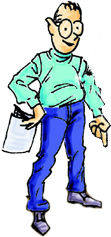For cartoonist George Feyer, everything was fair game. A notorious prankster with a flair for the provocative, he earned entry to Canada in 1948 by using his drawing skills to forge his immigration papers. It was those same skills which earned him a high-profile illustration career and later appearances on CBC Television during the 1950s and 60s, including such shows as Razzle Dazzle and The Observer. This clip from the Joan Fairfax Show is a perfect display of Feyer's lightning fast wit and rapid drawing skills.
Feyer's rise to fame and fortune began in 1954 with his first appearance on the CBC children's show Telestory Time, where he would draw images for a story while the host read along. Over the next decade, he regularly appeared on several adult shows, penned a syndicated comic strip named Feyer's Fair and became friends with the likes of Lister Sinclair, Marshall McLuhan, Steve Allen, Mort Sahl and Danny Kaye. But his success was not to last. In 1965, he moved to California to further his career, but was found dead in his apartment two years later.
? George Feyer was born to Jewish family in Budapest in 1921 and grew up during the Nazi occupation of Hungary. A natural cartoonist as a child, he was drafted into the German army as an artist and illustrator.
? He later used these skills to forge papers that helped him and his mother slip out of Hungary and into Canada. They were later accepted here as refugees.
? They moved to Toronto, where he got a job stuffing feathers into duvets for $18 a week.
? In 1949, he sent a cartoon to Maclean's magazine, where he was published for the first time. Around 1954, he began appearing on children's television shows as the resident "funnyman" cartoonist.
? On Razzle Dazzle, he donned a beret and smock to illustrate the adventures of Percy Kidpester, Terwilleger Topsoil and J. Tipton Teabag.
? He became known for his lightning sketches, once drawing a 30-foot-long mural in three and a half minutes.
? In the late 1950s, Feyer married Michaella FitzSimons, a Canadian. Their only child, Anthony Feyer, was born in 1960. Tony Feyer is now an artist who lives and works in New York City.
? By the 1960s, George Feyer was associating with the likes of Pierre Berton, Lister Sinclair and Marshall McLuhan. Dubbed "the enfant terrible of Toronto's media set" by Terry Mosher (aka Aislin), Feyer was known to draw elaborate (and profane) pictures behind artworks and would draw impromptu art on the bare shoulders of women.
? At the height of his success in Canada, Feyer owned a home in Toronto's affluent Rosedale neighbourhood and took his family on annual two-month vacations in Europe and South America.
? In the 1960s he also briefly plied his trade on Hockey Night in Canada, where he drew quick sketches to accompany the commentary during the intermissions.
? Feyer's endless creativity is remembered in the Canadian cartoon history book The Hecklers which says "despite being highly inventive and extremely prolific, much of Feyer's better work - reflections on religion, sex, and politics - still remains unpublished."
? In a February 2004 piece for the Daily Telegraph newspaper, Barbara Amiel recalled an encounter with Feyer at the CBC: "Years ago, when I worked in the Canadian Broadcasting Corporation, I came upon the late Hungarian-Jewish cartoonist George Feyer hunched over a table in the cafeteria. He was working feverishly putting together a little plastic Crucifixion kit for children, with a look of glee upon his face."
? In 1965, Feyer left Toronto to produce television shows in Hollywood.
? Despite making such famous contacts as Woody Allen and Lenny Bruce, his career was cut tragically short on March 30, 1967, when his body was discovered in his apartment by a friend.
? A coroner ruled Feyer died from a self-inflicted gunshot wound to the head. He was 46 years old.
? Writing in the Toronto Star, Pierre Berton called Feyer "the most inventive man I have ever known" and cited several of his many projects which included three-dimensional ceramic cartoons, several unpublished books, ideas for game shows and a stage musical.
? "He was a loner by choice and he was lonely," Berton wrote. "He died alone, of course?no neighbour bestirred himself to investigate so George lay, quite alone, for almost four days surrounded by his work ? drawings everywhere: drawings on the walls and the ceilings, drawings on the radiators and the bathroom tile, drawings on the very door handles."
? To watch the CBC's Lister Sinclair eulogize Feyer, go to our additional clip: Remembering George.
Feyer's Fair
Program: The Joan Fairfax Show
Guest(s): George Feyer
Host: Joan Fairfax
Duration: 4:02
Click Here To Listen ToVideo...Broadcast Date: Oct. 18, 1959















